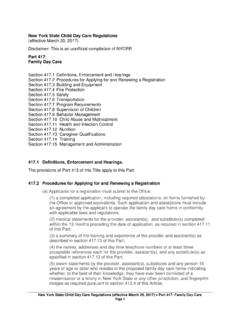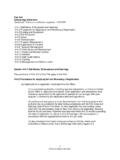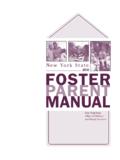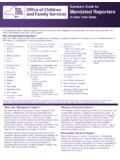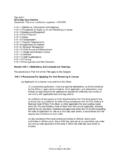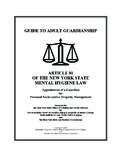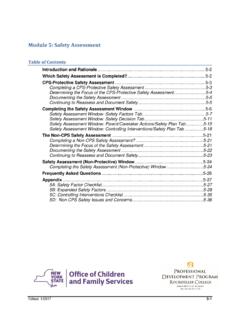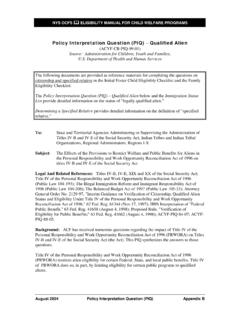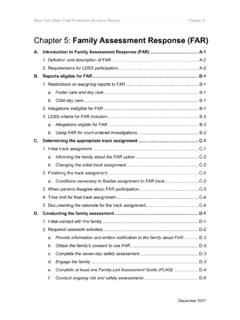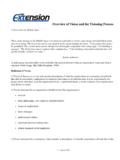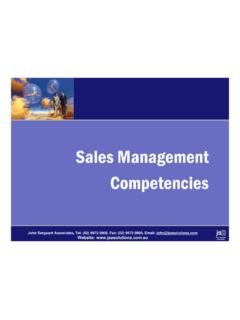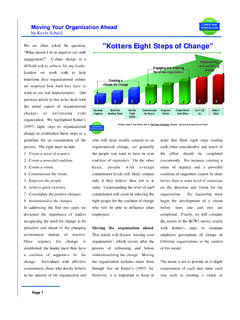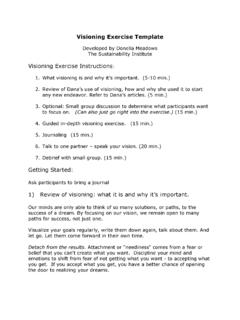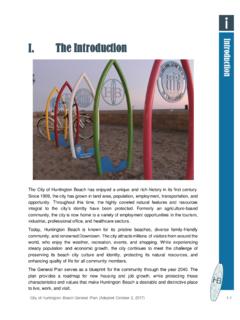Transcription of Handout #1 THE CHANGE PROCESS - ocfs.ny.gov
1 Handout #1 THE CHANGE PROCESS UNFREEZING --THE STATUS QUO CHANGING--THROUGH A SET OF ACTIONS REFREEZING--INTO A STABLE PATTERN Handout #2 THE CHANGE PROCESS UNFREEZING: CHANGE may be initiated by a crisis in the organization, new demands placed on the organization, or inno- vation proposed by someone in the organization. The old ways are opened to questions, and the climate for CHANGE exists. CHANGING: CHANGE occurs through a random PROCESS of looking for new solutions, or a planned approach to solving a problem.
2 There is uncertainty, confusion, searching and probably conflict. REFREEZING: CHANGE slows, as new ways replace the old ones and become standard practice. members accept the new situation. Handout #3 THE SUPERVISOR AS CHANGE AGENT 1. Creates a vision of how things can be done better. 5. Persist until the 2. Translates visions agendas get INNOVATION into visible accomplished.
3 CHANGE agendas. 4. Establishes a climate 3. Communicates of problem solving agendas so that and learning around others want to the agendas. buy in. Many supervisors feel powerless in their role during CHANGE , being squeezed between pressures from above and below. There are some things you can do to lead your group into the future. For instance you can empower your team to make changes themselves by focusing on the following: Focus on the PROCESS Surface tough issues; pay attention to how things get done, manage context.
4 Problem-solving orientation Don t blame. Fix systems not people. Learning environment Lots of information and listening. Shared responsibility Accountability and mutual contacts. Handout #4 THE SEVEN DYNAMICS OF CHANGE The Seven Dynamics of CHANGE are listed below. Think about how the dynamics apply to a CHANGE situation at work. Dynamic 1: People will feel awkward, ill-at-ease and self-conscious. Dynamic 2: People will think about what they have to give up. Dynamic 3: People will feel alone even if everyone else is going through the CHANGE . Dynamic 4: People can handle only so much CHANGE .
5 Dynamic 5: People are at different levels of readiness for CHANGE . Dynamic 6: People will be concerned that they don t have enough resources (time, money, skills, etc.). Dynamic 7: If you take the pressure off, people will revert back to old behavior. Handout #5 REACTIONS TO CHANGE IDENTITY, COMMITMENT COOPERATION SUPPORT ACCEPTANCE NEUTRALITY INDIFFERENCE APATHY FOOT DRAGGING COMPLAINTS ATTACK.
6 SABOTAGE Handout #6 REASONS FOR RESISTANCE The proposed CHANGE appears to violate values/ethics Inertia already exists in the system The proposed changes represent uncertainty A misunderstanding of proposed changes is evident There is a fear of loss There is a threat to the security of organizational members Personal antagonism exists among group members There is a lack of confidence in the CHANGE sponsor(s) There is a lack of confidence in the CHANGE agent(s) There is a lack of participation among team members There is a failure to see the need for CHANGE The timing is very poor There is a disruption of social relationships The proposed CHANGE could upset power balances Informal organizational pressure against the CHANGE is possible There is a belief that the CHANGE is a form of criticism about the way things have been done There is a perception that benefits may result if there is a strong resistance to CHANGE Handout #7 CHANGE AND LOSS CHANGE occurs when something ends and something new or different starts.
7 The period between these two points is transition. This is where people have to learn to let go of the old and embrace the new. Usually it means moving from the familiar to the unknown. Even when CHANGE is positive, this psychological PROCESS affects us. Most of us have a strong response to any CHANGE . One of the strongest can be a feeling of loss, along with the struggle to accept a new direction. CHANGE can produce physical symptoms such as sweating, sleep loss and/or emotional distress which, will affect the quality of work. The most common error in managing CHANGE is underestimating the affect it has on people.
8 Many supervisors think that if they just tell their employees to CHANGE , they will. They do not realize how upsetting it is to give up work patterns that are familiar. Always remember how much will be disrupted and understand that people need time to adjust. Even when CHANGE is positive it is not uncommon for a person to feel an ending, or loss, associated with it. Supervisors often have a hard time understanding the loss associated with CHANGE . If you don't manage loss, you can't lead people in a new direction. Types of Loss When a major shift or CHANGE occurs within an organization, employees normally experience several types of loss including the loss of: Security-Employees no longer feel in control or know what the future holds, or where they stand in the organization.
9 Competence-Workers no longer feel that they know what to do or how to manage. People sometimes become embarrassed when they are faced with new tasks because they don't know how to do them. It is hard to admit you don't know how to do something. Relationships- The familiar contact with people like old clients, co-workers or supervisors can disappear. People often lose their sense of belonging to a team, a group or an organization. Sense of Direction-Employees lose an understanding of where they are going and why they are going there. Meaning and mission often become unclear. Territory- There is an uncertain feeling about the area that used to belong to them.
10 This can be work space or job assignments. Territory includes psychological space as well as physical space. Each of the losses described has a cost. Any type of loss, even of a work space or familiar technology, can trigger an emotional response that resembles grief. You must help your employees move past their loss to accept and move forward in the new direction. It is important to understand that people are not weak or old-fashioned if they experience loss caused by CHANGE . This is a normal part of transition. In fact, people who do not display any feeling of loss often save it up and become overcome by a seemingly small transition.

